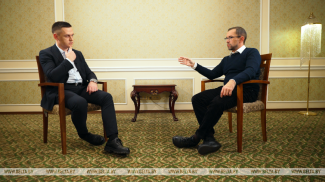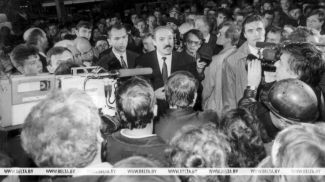The first Belarusian book, The Psalter, was published in Prague 500 years ago, on 6 August 1517. The book is considered to be one of the most popular and widespread books of the Bible. This book printed by Francysk Skaryna gave a start to the Belarusian book printing that developed as part of the European and East-Slavonic book printing.
Handwritten books came to Belarus with the advent of Christianity.
Books cost a lot back then!
It took from several months to several years to make a book. A well-copied and properly bound book was as expensive as a herd of horses.
Prominent Belarusians Euphrosyne of Polotsk and Kirill of Turov believed that book copying was an important and noble task.
But technological progress marched on...
The next milestone in the technological evolution was xylography or woodblock printing. The same woodblocks were used over and over to print the same pieces of text.
German inventor Johannes Gutenberg upgraded the technology by making mirrored letters out of metal in the 1440s. Known as movable type, the letters were combined into lines, covered with ink and pressed on paper. That was how the European book printing came into being.
In approximately 1490 a boy was born into the family of wealthy merchant Luka Skaryna. The boy grew up to be a great Belarusian and European enlightener. He often used the image of the sun and the moon in his engravings.
Francysk was an ardent student. At first he studied in Polotsk and then embarked on a long journey of knowledge.
First Francysk graduated from the university of Krakow and the university of Padua in Italy. After that he went to Prague. He didn't go there to appreciate the local cuisine. His goals were more ambitious than that: he set out to print a Bible in the language of his people. But it was an expensive venture and the money was hard to get. The help came from patrons of art.
In Prague Francysk Skaryna ordered the printing equipment and started translating Bible books into Slavonic. He wrote comments to every book. The Psalter came out in August 1517. It was the first book for Eastern Slavs. Francysk Skaryna made sure his image would be remembered through ages by placing his own portrait on pages of the Bible books. Quite an unprecedented step in that time.
In Prague Francysk Skaryna prepared over 20 books of the Bible for printing. Each had its own foreword and afterword.
Around 1520 Francysk Skaryna moved to Vilna where he opened the first printing house in the Grand Duchy of Lithuania. The Little Travel Book was printed in 1522. It was kind of a guidebook for travelers. It contained prayers and psalms and also the information about religious holidays, eclipse dates, equinox and solstice days.
With the death of major sponsors of the printing house in Vilna, Skaryna's publishing business gradually came to a halt. Yet the development of the Belarusian book printing could not be stopped.
The first printing house in the territory of modern Belarus was established in Brest by Nikolai Radziwill nicknamed Chorny or the Black in 1553. The printing house made a genuine masterpiece in 1563 — the Brest Bible also known as the Radziwill Bible. The book had a leather binding, 738 pages, multiple engravings and vignettes. Prince Radziwill paid a fortune for it — 10 thousand ducats or a year's worth of income.
His relatives who had different religious views burned nearly all the copies of the book after the prince died.
A printing house in Nesvizh was founded in the second half of the 16th century. For some time the printing house was run by prominent Renaissance thinker Symon Budny. He printed the famous Catechism there. It was a hot topic for debates among educated people in the Grand Duchy of Lithuania and far abroad.
The printing pioneers Piotr Mstislavets and Ivan Fyodorov worked in Belarus in the late 1560s. They opened a printing house near Grodno and made a Bible for teachers in 1569. The book was very popular and was republished many times.
In the Grand Duchy of Lithuania of the late 16th century books were printed mainly by religious brotherhoods at Orthodox churches and monasteries. The brotherhoods also printed textbooks. For instance, the Vilna brotherhood printing house in the town of Yevye published the Slavonic Grammar textbook by Melety Smotrytsky. Mikhail Lomonosov used this book when a child and later described this textbook and two others as his gateway to knowledge.
There were 21 printing houses in the Belarusian lands of the Russian Empire at the beginning of the 19th century. The books were initially printed in Polish and then in Russian. Books in Belarusian were few. But the Belarusian language survived, however, as it was spoken by simple folks.
The book printing in Belarusian was revived thanks to… jokes. No kidding! Comedies and poetry full of jokes were among the first books in Belarusian. Taras Na Parnase and Eneida Navyvarat were so popular that people knew them by heart although the books were published only decades after they were written.
The first legal Belarusian printing houses were established after the Russian Revolution in 1905. The Belarusian saying “The sun will shine our way, too” was adopted as the name of the association of Belarusian printers, which was founded in Saint Petersburg in 1906. The association printed the books by Belarusian writers and poets such as Yanka Kupala, Zmitrok Byadulya and Tsishka Gartny.
The Belarusian national publishing house was established in 1921. Today it is known as Belarus publishing house.
In those turbulent times of revolutions and wars people were well aware of the power of the printed word. For example, mobile printing houses were widely used by local partisans and underground fighters during the Great Patriotic War in Belarus.
The offset press, which changed the printing industry, was invented at the beginning of the 20th century. The invention of computers in the middle of the 20th century made printing even easier.
The Belarusian book printing industry keeps pace with the times. Today Belarus is home to about 500 printing houses that print over 20 million books every year or more than two books per one resident.












